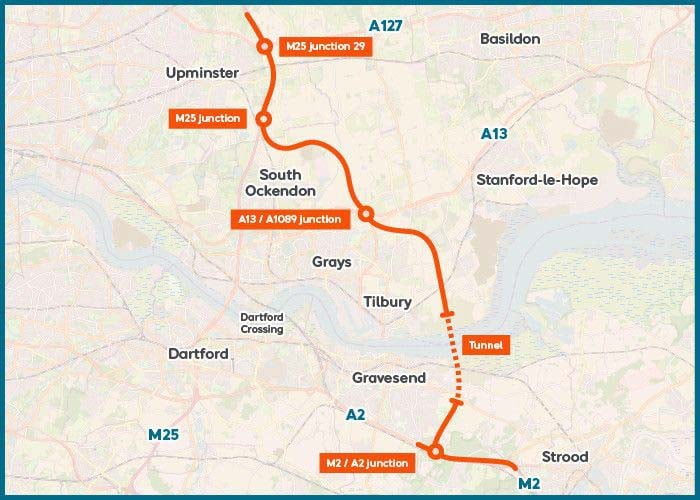With London’s congestion a constant problem for drivers, there has been a 15-year plan to start construction on a new route in and out of the city.
In this know how guide, we explain what the Crossing is, when it will be built, the routes it will take, and how recent political developments have impacted the plans.
Lower Thames Crossing
The River Thames is an iconic landmark in the UK – and by 2032, there will be a new tunnel that will travel underneath it.
Drivers will be connected from Kent to Essex, to the East of London – and is designed to relieve the congestion at the nearby Dartford Crossing.
That is currently the only road crossing over the Thames on the eastern side of the capital.
National Highways stated: “The Dartford Crossing is one of our most vital roads, but also one of our most unreliable – the Lower Thames Crossing will ease congestion, and open up new opportunities
“Its unique position as the only road across the Thames east of London makes the Dartford Crossing one of the most strategically vital roads in the UK, connecting people to jobs, businesses to customers, and some of the country's biggest ports and distribution hubs.”
Although its main goal is to improve traffic conditions, the Government also hopes it will increase the local economy in the region.
There are also aims to improve the impact congestion currently has on the environment.
Matt Palmer, Executive Director, Lower Thames Crossing said: “The Lower Thames Crossing will tackle congestion at the Dartford Crossing, while also serving as a carbon pathfinder project to showcase our ability to develop essential infrastructure in a Net Zero future.
“The foundation for this is our people, and it’s incredibly important we have a better understanding of how by working together, individual small actions can make a real difference - on this project, on the next, and on the UK’s pathway to net zero.”
Lower Thames Crossing route
The A122 Lower Thames Crossing would connect to the A2 and M2 in Kent to the A13 in Thurrock and junction 29 of the M25 in the London Borough of Havering.
According to National Highways, the tunnel itself would be approximately 14.3 miles long, with 2.6 miles of this in two tunnels under the River Thames.
Should construction go ahead, it would make them the longest road tunnels in the UK.
The tunnels would be located to the east of the village of Chalk on the south side of the Thames, and to the west of East Tilbury on the north side.
Once complete, the Lower Thames Crossing will almost double road capacity across the River Thames, to east of London.
Lower Thames Crossing map
Here is a map of the scheduled Lower Thames Crossing:

When will the Lower Thames Crossing be built?
If final approval is granted, and construction can begin, then the Lower Thames Crossing – including the northbound and southbound tunnels – will be completed in 2032.
Construction will begin in 2026, should the Development Consent Order by granted by the end of 2024.
Impact of 2024 General Election
Due to the General Election on July 4th 2024 – and to allow appropriate time for the new Secretary of State for Transport Louise Haigh to consider the planning application of the Lower Thames Crossing, the deadline for a decision has been extended until October 4th 2024.
The extension was announced by previous Transport Secretary Mark Hooper in May.
In a statement, the Government revealed that the A122 (Lower Thames Crossing) Development Consent Order for the proposed development by National Highways for a new road crossing connecting Kent, Thurrock, and Essex would have a new deadline of October 4th and the application will include any developments that will connect to the existing road network from the A2/M2 to the M25 with two tunnels (one southbound and one northbound) running beneath the River Thames.
Although the initial stages of this plan were submitted in 2009, there has been a series of consultations from the public, Department for Transport (DfT), and local communities.
However, there was a timeline to seek a Development Consent Order by the end of 2024 – where permission will be granted to start construction.
Even if everything goes ahead as planned, the initial groundwork will not take place until 2026 – and will take another six years to complete.
This means that by 2032, the Lower Thames Crossing should be open to traffic.

Cheaper than AA or we'll beat by 20%^
• Roadside cover from £5.49 a month*
• We get to most breakdowns in 60 mins or less
• Our patrols fix 4/5 breakdowns on the spot











